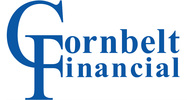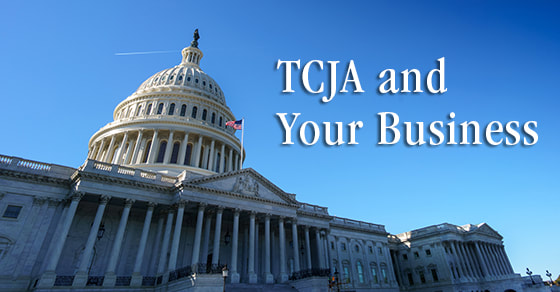|
The recently passed tax reform bill, commonly referred to as the “Tax Cuts and Jobs Act” (TCJA), is the most expansive federal tax legislation since 1986. It includes a multitude of provisions that will have a major impact on businesses.
Here’s a look at some of the most significant changes. They generally apply to tax years beginning after December 31, 2017, except where noted.
Keep in mind that additional rules and limits apply to what we’ve covered here, and there are other TCJA provisions that may affect your business. Contact us for more details and to discuss what your business needs to do in light of these changes. © 2017
0 Comments
On December 20, Congress completed passage of the largest federal tax reform law in more than 30 years. Commonly called the “Tax Cuts and Jobs Act” (TCJA), the new law means substantial changes for individual taxpayers.
The following is a brief overview of some of the most significant provisions. Except where noted, these changes are effective for tax years beginning after December 31, 2017, and before January 1, 2026.
Be aware that additional rules and limits apply. Also, there are many more changes in the TCJA that will impact individuals. If you have questions or would like to discuss how you might be affected, please contact us. © 2017 Various limits apply to most tax deductions, and one type of limit is a “floor,” which means expenses are deductible only if they exceed that floor (typically a specific percentage of your income). One example is the medical expense deduction.
Because it can be difficult to exceed the floor, a common strategy is to “bunch” deductible medical expenses into a particular year where possible. If tax reform legislation is signed into law, it might be especially beneficial to bunch deductible medical expenses into 2017. The deduction Medical expenses that aren’t reimbursable by insurance or paid through a tax-advantaged account (such as a Health Savings Account or Flexible Spending Account) may be deductible — but only to the extent that they exceed 10% of your adjusted gross income. The 10% floor applies for both regular tax and alternative minimum tax (AMT) purposes. Beginning in 2017, even taxpayers age 65 and older are subject to the 10% floor. Previously, they generally enjoyed a 7.5% floor, except for AMT purposes, where they were also subject to the 10% floor. Benefits of bunching By bunching nonurgent medical procedures and other controllable expenses into alternating years, you may increase your ability to exceed the applicable floor. Controllable expenses might include prescription drugs, eyeglasses and contact lenses, hearing aids, dental work, and elective surgery. Normally, if it’s looking like you’re close to exceeding the floor in the current year, it’s tax-smart to consider accelerating controllable expenses into the current year. But if you’re far from exceeding the floor, the traditional strategy is, to the extent possible (without harming your or your family’s health), to put off medical expenses until the next year, in case you have enough expenses in that year to exceed the floor. However, in 2017, sticking to these traditional strategies might not make sense. Possible elimination? The nine-page “Unified Framework for Fixing Our Broken Tax Code” that President Trump and congressional Republicans released on September 27 proposes a variety of tax law changes. Among other things, the framework calls for increasing the standard deduction and eliminating “most” itemized deductions. While the framework doesn’t specifically mention the medical expense deduction, the only itemized deductions that it specifically states would be retained are those for home mortgage interest and charitable contributions. If an elimination of the medical expense deduction were to go into effect in 2018, there could be a significant incentive for individuals to bunch deductible medical expenses into 2017. Even if you’re not close to exceeding the floor now, it could be beneficial to see if you can accelerate enough qualifying expense into 2017 to do so. Keep in mind that tax reform legislation must be drafted, passed by the House and Senate and signed by the President. It’s still uncertain exactly what will be included in any legislation, whether it will be passed and signed into law this year, and, if it is, when its provisions would go into effect. For more information on how to bunch deductions, exactly what expenses are deductible, or other ways tax reform legislation could affect your 2017 year-end tax planning, please contact us. © 2017 Timing strategies could become more powerful in 2017, depending on what happens with tax reform12/7/2017 Projecting your business income and expenses for this year and next can allow you to time when you recognize income and incur deductible expenses to your tax advantage. Typically, it’s better to defer tax. This might end up being especially true this year, if tax reform legislation is signed into law.
Timing strategies for businesses Here are two timing strategies that can help businesses defer taxes: 1. Defer income to next year. If your business uses the cash method of accounting, you can defer billing for your products or services. Or, if you use the accrual method, you can delay shipping products or delivering services. 2. Accelerate deductible expenses into the current year. If you’re a cash-basis taxpayer, you may make a state estimated tax payment before December 31, so you can deduct it this year rather than next. Both cash- and accrual-basis taxpayers can charge expenses on a credit card and deduct them in the year charged, regardless of when the credit card bill is paid. Potential impact of tax reform These deferral strategies could be particularly powerful if tax legislation is signed into law this year that reflects the nine-page “Unified Framework for Fixing Our Broken Tax Code” that President Trump and congressional Republicans released on September 27. Among other things, the framework calls for reduced tax rates for corporations and flow-through entities as well as the elimination of many business deductions. If such changes were to go into effect in 2018, there could be a significant incentive for businesses to defer income to 2018 and accelerate deductible expenses into 2017. But if you think you’ll be in a higher tax bracket next year (such as if your business is having a bad year in 2017 but the outlook is much brighter for 2018 and you don’t expect that tax rates will go down), consider taking the opposite approach instead — accelerating income and deferring deductible expenses. This will increase your tax bill this year but might save you tax over the two-year period. Be prepared Because of tax law uncertainty, in 2017 you may want to wait until closer to the end of the year to implement some of your year-end tax planning strategies. But you need to be ready to act quickly if tax legislation is signed into law. So keep an eye on developments in Washington and contact us to discuss the best strategies for you this year based on your particular situation. © 2017 In today’s rough-and-tumble world of mergers and acquisitions (M&As), buyers need to get to know business sellers and their executives, test their representations about asset condition and financial performance, and screen for common fraud schemes. Here’s why.
Whose side are they on? Without adequate M&A due diligence, unwary buyers could fall victim to false representations by sellers that never pan out after the deal closes. Or they may inherit a hornet’s nest of white collar crime and embezzlement by employees. Even if a company has internal controls in place, owners and executives can override them. These individuals have access to financial statements, and may have incentives — such as to receive bonuses for exceeding certain growth targets — to falsify them. So it’s essential to perform background checks on your acquisition target’s owners and C-suite executives. A thorough check can uncover past involvement in criminal embezzlement, theft, forgery and other types of fraud, as well as involvement in civil litigation. It could also reveal falsified items on their resumés and other pertinent personal claims. How “creative” is the business? Financial statements should also be scoured for misstatements. Some owners may use “creative” accounting techniques to artificially inflate a company’s value. They might, for example:
Tip of the iceberg Unfortunately, this is just the tip of the iceberg when it comes to fraud schemes that could diminish the value of your acquisition. In addition to performing financial and legal due diligence, be sure to tour your target’s facilities and interview management for insight into the company’s culture. For help conducting due diligence, please contact us. © 2017 A tried-and-true tax-saving strategy for investors is to sell assets at a loss to offset gains that have been realized during the year. So if you’ve cashed in some big gains this year, consider looking for unrealized losses in your portfolio and selling those investments before year end to offset your gains. This can reduce your 2017 tax liability.
But what if you expect an investment that would produce a loss if sold now to not only recover but thrive in the future? Or perhaps you simply want to minimize the impact on your asset allocation. You might think you can simply sell the investment at a loss and then immediately buy it back. Not so fast: You need to beware of the wash sale rule. The rule up close The wash sale rule prevents you from taking a loss on a security if you buy a substantially identical security (or an option to buy such a security) within 30 days before or after you sell the security that created the loss. You can recognize the loss only when you sell the replacement security. Keep in mind that the rule applies even if you repurchase the security in a tax-advantaged retirement account, such as a traditional or Roth IRA. Achieving your goals Fortunately, there are ways to avoid the wash sale rule and still achieve your goals:
For more ideas on saving taxes on your investments, please contact us. © 2017 If you own a profitable, unincorporated business with your spouse, you probably find the high self-employment (SE) tax bills burdensome. An unincorporated business in which both spouses are active is typically treated by the IRS as a partnership owned 50/50 by the spouses. (For simplicity, when we refer to “partnerships,” we’ll include in our definition limited liability companies that are treated as partnerships for federal tax purposes.)
For 2017, that means you’ll each pay the maximum 15.3% SE tax rate on the first $127,200 of your respective shares of net SE income from the business. Those bills can mount up if your business is profitable. To illustrate: Suppose your business generates $250,000 of net SE income in 2017. Each of you will owe $19,125 ($125,000 × 15.3%), for a combined total of $38,250. Fortunately, there are ways spouse-owned businesses can lower their combined SE tax hit. Here are two. 1. Establish that you don’t have a spouse-owned partnership While the IRS creates the impression that involvement by both spouses in an unincorporated business automatically creates a partnership for federal tax purposes, in many cases, it will have a tough time making the argument — especially when:
Let’s assume the same facts as in the previous example, except that your business is a sole proprietorship operated by one spouse. Now you have to calculate SE tax for only that spouse. For 2017, the SE tax bill is $23,023 [($127,200 × 15.3%) + ($122,800 × 2.9%)]. That’s much less than the combined SE tax bill from the first example ($38,250). 2. Establish that you don’t have a 50/50 spouse-owned partnership Even if you do have a spouse-owned partnership, it’s not a given that it’s a 50/50 one. Your business might more properly be characterized as owned, say, 80% by one spouse and 20% by the other spouse, because one spouse does much more work than the other. Let’s assume the same facts as in the first example, except that your business is an 80/20 spouse-owned partnership. In this scenario, the 80% spouse has net SE income of $200,000, and the 20% spouse has net SE income of $50,000. For 2017, the SE tax bill for the 80% spouse is $21,573 [($127,200 × 15.3%) + ($72,800 × 2.9%)], and the SE tax bill for the 20% spouse is $7,650 ($50,000 × 15.3%). The combined total SE tax bill is only $29,223 ($21,573 + $7,650). More-complicated strategies are also available. Contact us to learn more about how you can reduce your spouse-owned business’s SE taxes. © 2017 One important step to both reducing taxes and saving for retirement is to contribute to a tax-advantaged retirement plan. If your employer offers a 401(k) plan, contributing to that is likely your best first step. If you’re not already contributing the maximum allowed, consider increasing your contribution rate between now and year end. Because of tax-deferred compounding (tax-free in the case of Roth accounts), boosting contributions sooner rather than later can have a significant impact on the size of your nest egg at retirement. Traditional 401(k) A traditional 401(k) offers many benefits:
For 2017, you can contribute up to $18,000. So if your current contribution rate will leave you short of the limit, try to increase your contribution rate through the end of the year to get as close to that limit as you can afford. Keep in mind that your paycheck will be reduced by less than the dollar amount of the contribution, because the contributions are pre-tax so income tax isn’t withheld. If you’ll be age 50 or older by December 31, you can also make “catch-up” contributions (up to $6,000 for 2017). So if you didn’t contribute much when you were younger, this may allow you to partially make up for lost time. Even if you did make significant contributions before age 50, catch-up contributions can still be beneficial, allowing you to further leverage the power of tax-deferred compounding. Roth 401(k) Employers can include a Roth option in their 401(k) plans. If your plan offers this, you can designate some or all of your contribution as Roth contributions. While such contributions don’t reduce your current MAGI, qualified distributions will be tax-free. Roth 401(k) contributions may be especially beneficial for higher-income earners, because they don’t have the option to contribute to a Roth IRA. On the other hand, if you expect your tax rate to be lower in retirement, you may be better off sticking with traditional 401(k) contributions. Finally, keep in mind that any employer matches to Roth 401(k) contributions will be pretax and go into your traditional 401(k) account. How much and which type Have questions about how much to contribute or the best mix between traditional and Roth contributions? Contact us. We’d be pleased to discuss the tax and retirement-saving considerations with you. © 2017 Updated travel per diem rates go into effect October 1. To simplify recordkeeping, they can be used for reimbursement of ordinary and normal business expenses incurred while employees travel away from home. Per diem advantages As long as employees properly account for their business-travel expenses, reimbursements are generally tax-free to the employees and deductible by the employer. But keeping track of actual costs can be a headache. With the per diem rates, employees don’t have to keep receipts for covered travel expenses. They just need to document the time, place and business purpose of the travel. Assuming that the travel qualifies as a business expense, the employer simply pays the employee the per diem allowance designated for the specific travel destination and deducts the per diem paid. Although the per diem rates are set by the General Services Administration (GSA) to cover travel by government employees, private employers may use them for tax purposes. The rates are updated annually for the following areas:
What’s new? For October 1, 2017, through September 30, 2018, the per diem standard CONUS rate is $144, an increase of $2 over the prior year. This rate consists of $93 for lodging and $51 for M&IE. Also effective October 1, there are 332 NSAs. The following locations have moved from NSAs into the standard CONUS rate:
What’s right for you? As noted earlier, the per diem changes go into effect on October 1, 2017. During the last three months of 2017, an employer may switch to the new rates or continue with the old rates. But an employer must select one set of rates for this quarter and stick with it; it can’t use the old rates for some employees and the new rates for others. Because travel expenses often attract IRS attention, they require careful record-keeping. The per diem method can help, but it’s not the best solution for all employers. An even simpler “high-low” per diem method is also available. And, in some cases, a policy of reimbursing actual expenses could be beneficial, despite the record-keeping hassles. If you have questions regarding travel expense reimbursements, please contact us. © 2017 |
AuthorAdam Carr, MBA, EA Archives
June 2024
Categories
All
|










 RSS Feed
RSS Feed

